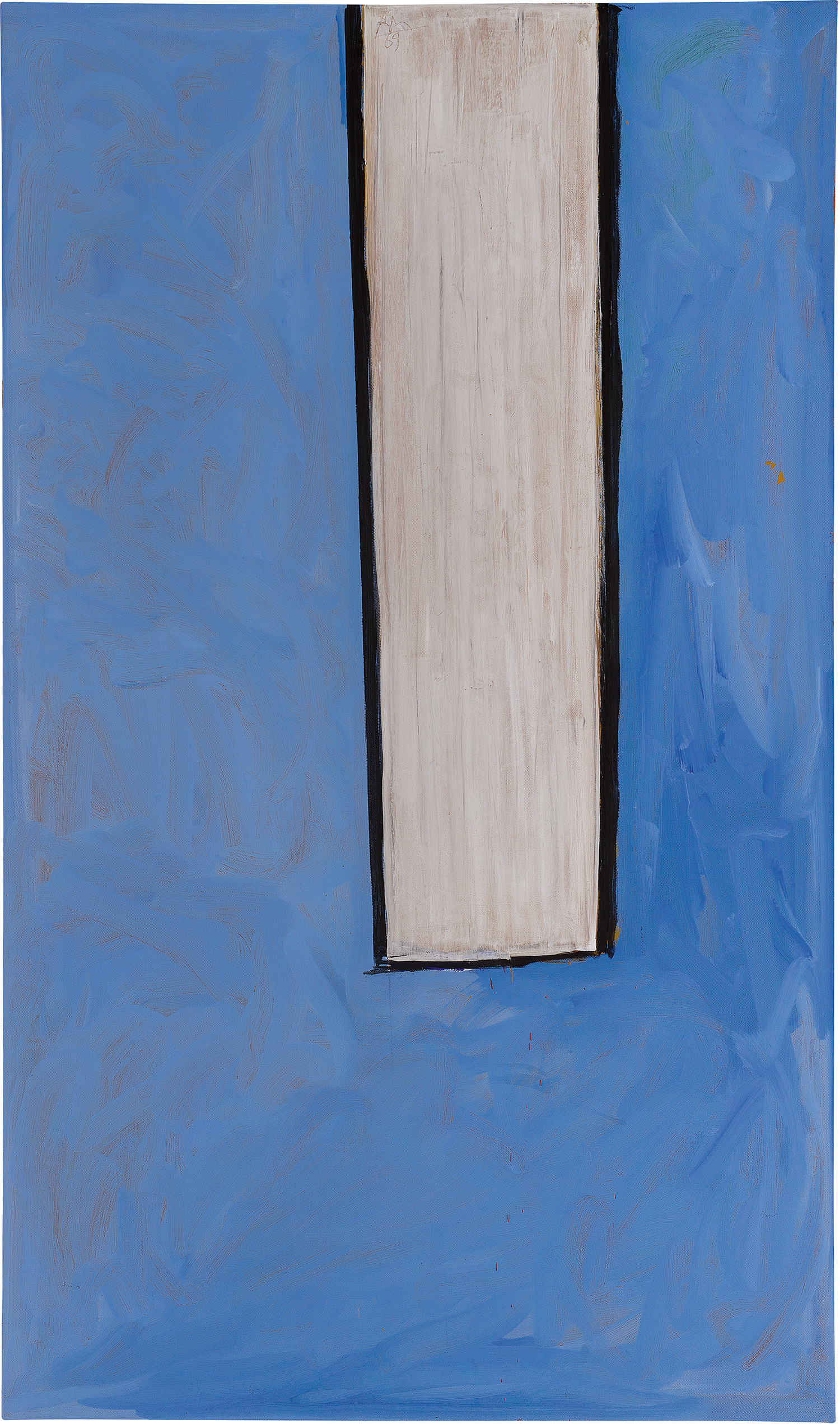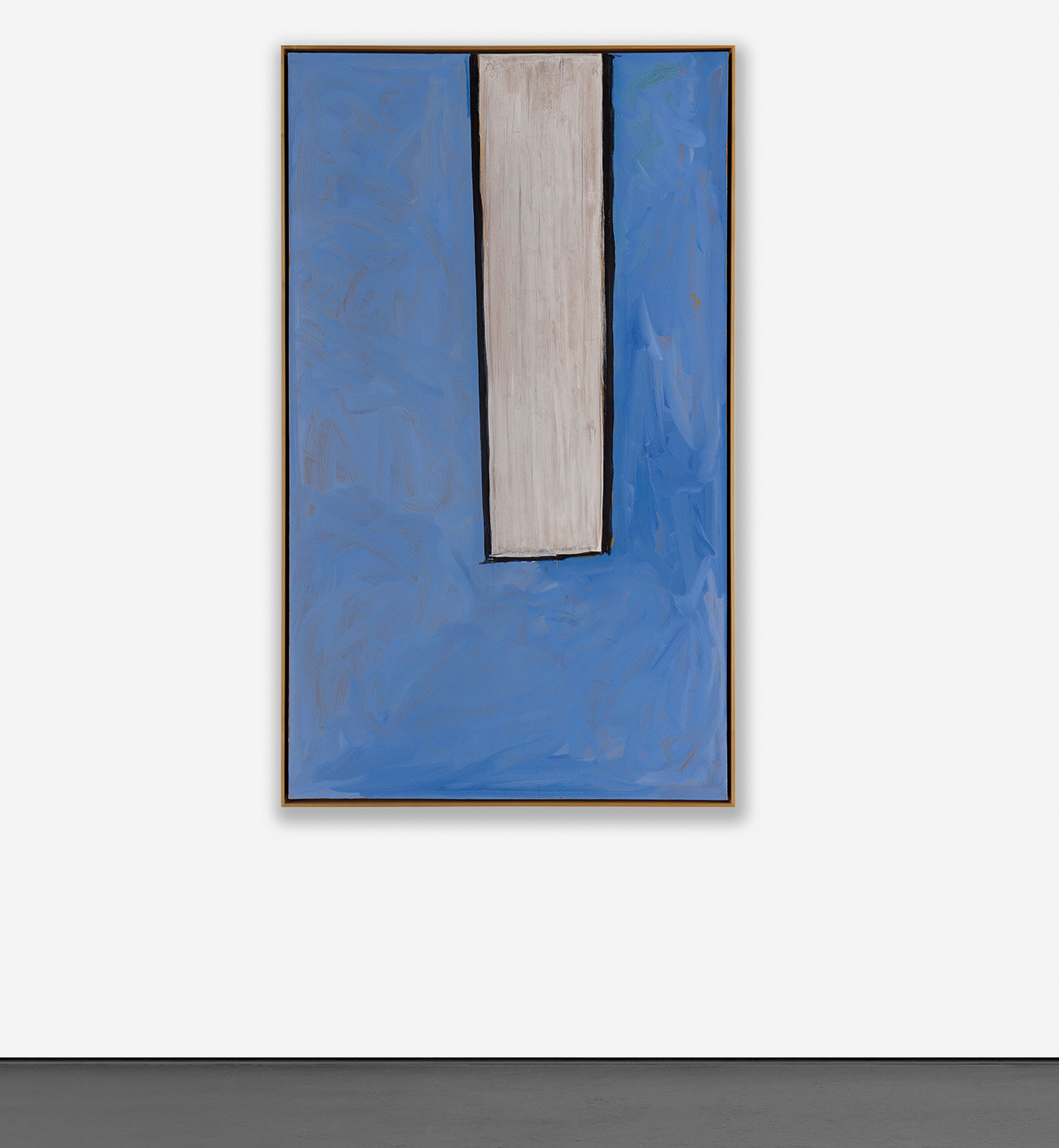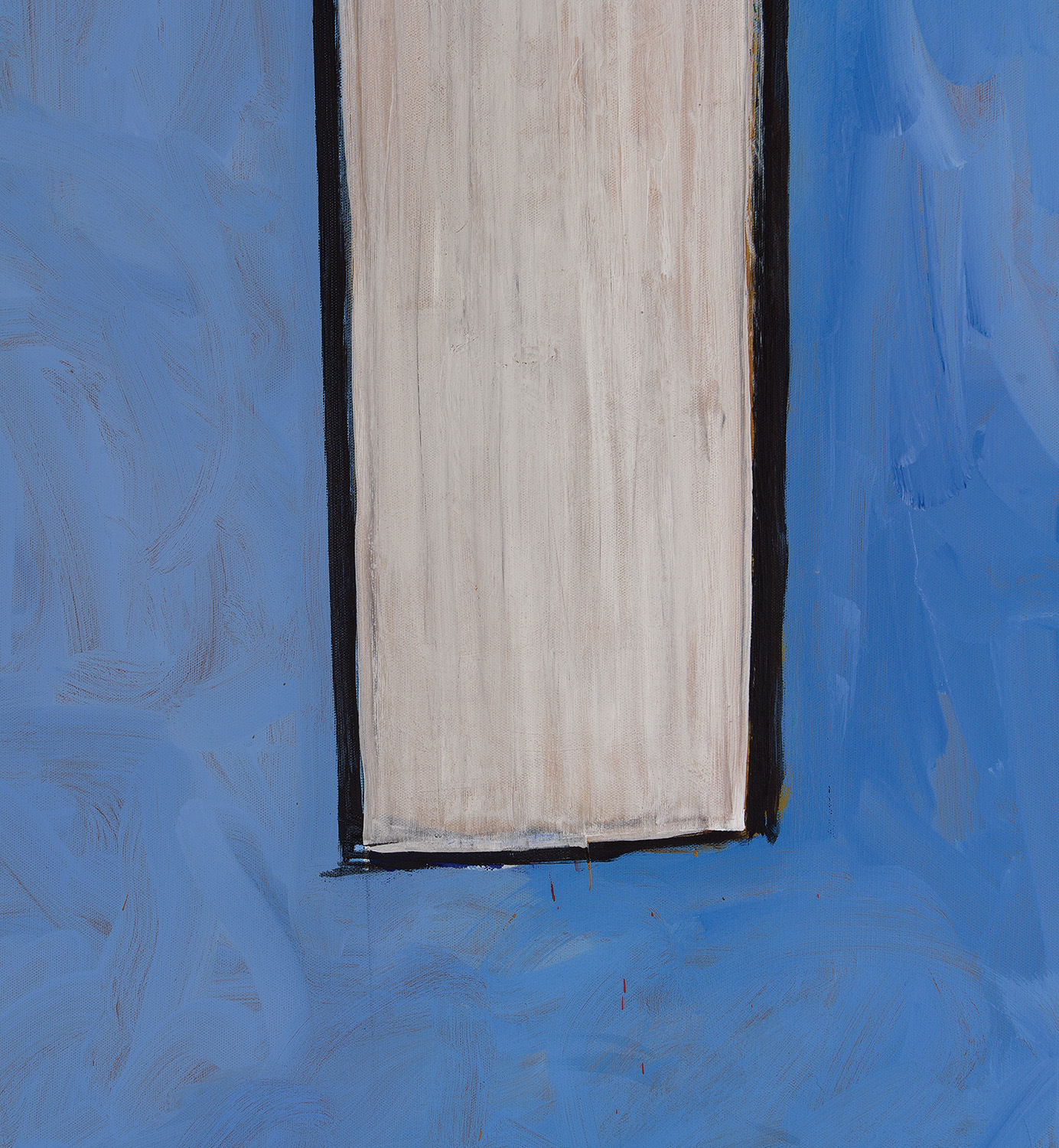





156
Robert Motherwell
Open No. 116: La France Open
Full-Cataloguing
“The relationship between some of the Opens and Matisse’s View of Notre Dame is striking, in terms of dialogue between drawn line and loosely brushed field of color, and even in the way the exquisite brushstroke in the ground is able to call forth so much luminosity and so much chromatic richness from the blues.��” – Jack Flam
Resplendent in color and gesture, Robert Motherwell’s Open No. 116: La France Open envelops the viewer in an atmospheric blue field of color anchored by a luminous white window-like form outlined in bold black lines. As one approaches the vast surface, hints of green, ultramarine blue, sienna and red begin to reveal themselves behind the veils of pale blue and white paint that Motherwell has gesturally applied in subtle, oftentimes semitransparent layers. Completed between 1983 and 1985, this work is the impressive result of over a decade and a half of constant re-working of the canvas: Motherwell began painting the work in 1969, initially conceived it as Open No. 116: In Sienna, Blue and Green, but over the years repeatedly revised the canvas until achieving its current, final state. Exemplary of Motherwell’s characteristic process of revision, this painting hence simultaneously exhibits elements of his early Opens, as well as the looser, more gestural style that Motherwell pursued in the last decade of his life in the 1980s. An ode to the color blue, Open No. 116: La France Open represents a striking continuation of Motherwell’s celebrated The Blue Painting Lesson paintings from 1973-1975, which reside in the Wadsworth Atheneum Museum of Art, in Hartford.
Encountering Open No. 116: La France Open is to experience an overwhelming sense of contemplation and Zen-like harmony that is wholly unique to Motherwell’s Open series. The Opens represented a major shift from the gestural brushstrokes and stark black and white of Motherwell’s preceding Elegies, an ongoing series begun in the late 1940s. If the Elegies were frequently imbued with undertones of tragedy and suffering, works such as the present example reflect the opposite spectrum of Motherwell’s sensibility. As Motherwell himself observed, “There is more emphasis on ‘feeling’ + less on ‘emotion.’ The ‘Open’ series is less aggressive than my older paintings” (Robert Motherwell, quoted in Irmeline Lebeer, “Robert Motherwell (Entretien avec l'artiste)”, Chroniques de Van vivant, no. 22, July-August 1971, n.p.).
The immediate origins of the Open series were inspired by chance when Motherwell was working in his studio in 1967. Struck by the relationship that resulted from leaning a smaller canvas against a larger one, he outlined the smaller canvas in charcoal on the larger one. According to Motherwell, “The series began as a ‘door’”, which he “ultimately reversed into a ‘window’” (Robert Motherwell, “Statement of the Open Series”, 1969, in Dore Ashton, ed., The Writings of Robert Motherwell, Berkeley, 2007, p. 244). That the first such Open painting was borne from a chance episode was not surprising for an artist such as Motherwell, who since his early contact with Surrealism held a firm belief in the generative potential of chance, memory and imagination.
Less immediately apparent to Motherwell, however, was that the theme of the window had already figured earlier in his career – a fact he realized more than a year after painting his first Opens upon rediscovering his Spanish Picture with Window, 1941, now in the collection of The Museum of Modern Art, New York. The Opens also reveal Motherwell’s engagement with the art historical motif of the window, likely prompted by his first in-person encounter with Henri Matisse’s highly abstracted Porte-fenêtre à Collioure, 1914, and the View of Notre Dame, 1914, at The Museum of Modern Art’s 1966 retrospective of the Fauve master. As Jack Flam indeed observed, “The relationship between some of the Opens and Matisse’s View of Notre Dame is striking, in terms of dialogue between drawn line and loosely brushed field of color, and even in the way the exquisite brushstroke in the ground is able to call forth so much luminosity and so much chromatic richness from the blues” (Jack Flam, in, Robert Motherwell Paintings and Collages: A Catalogue Raisonné, 1941 – 1991, vol. 1, New Haven, 2012, p. 134).
Though many of Motherwell’s Opens have naturalistic points of reference and often evoke the image of a window against a wall, the artist emphasized that the motif of the window mainly represented a poetic metaphor to him. It is indeed illuminating that Motherwell ultimately chose to title the series “Open” rather than “Windows,” which he had been considering up until early 1969. Skimming through his copy of the Random House Unabridged Dictionary of the English Language for new prompts and associations, Motherwell was intrigued by the conceptual breadth and ambiguity of the myriad of definitions for the word “open”. Echoing Stéphane Mallarmé’s belief that a poem should transcend a specific entity, idea, or event, Motherwell strove to create open-ended paintings. His paintings are neither meant as direct correspondences to the real world, nor are they exemplary of abstraction as an end in itself. Rather, they are meant to convey “felt content,” which in relation to the Opens Motherwell described as "colorful and sensuous, and in spatial depth” (Robert Motherwell, “Statement of the ‘Open’ Series”, 1969, in Dore Ashton, ed., The Writings of Robert Motherwell, Berkeley, 2007, pp. 123-124).
Open No. 116: La France Open is a remarkable example of how revision and re-painting formed a core part of Motherwell’s artistic process. The first version of this painting featured a sienna, blue and green composition and as such was titled Open No. 116: In Sienna, Blue and Green when it was consigned to Marlborough-Gerson Gallery in New York. By the time it was exhibited at Knoedler & Company in 1983, however, Motherwell had radically re-painted it – transforming it into a predominantly blue painting with a red Open form and titling it Open No. 116: La France Open. The work clearly held such significance to Motherwell that he revised it still one more time – painting the rectangular Open form white – to achieve his current composition. This form of constant re-working was a long-standing practice for Motherwell, who once stated, “…each brush stroke is a decision. It is not only a decision of aesthetics – will this look more beautiful? – but a decision that concerns one’s inner I” (Robert Motherwell, quoted in Robert Motherwell, exh. cat., Albright-Knox Art Gallery, Buffalo, 1983, pp. 12–13).
This constant process or revision, rather than being a matter of perfectionism, has been likened to an elusive attempt to find himself through the very act painting. Indeed, as Motherwell declared speaking of his tendency to re-paint works, “I realize that whatever ‘meaning’ that picture has is just the accumulated ‘meaning’ of ten thousand brush strokes, each one being decided as it was painted. In that sense, to ask what ‘what does this painting mean?’ is essentially unanswerable, except as the accumulation of hundreds of decisions with the brush. On a single day, or during a few hours, I might be in a very particular state, and make something much lighter, much heavier… than I normally would. But when you steadily work at something over a period of time, your whole being must emerge” (Robert Motherwell, quoted in Jack Flam et al., in Robert Motherwell, exh. cat., Albright-Knox Art Gallery, Buffalo, 1983, pp. 12–13).
Robert Motherwell
American | B. 1915 D. 1991One of the youngest proponents of the Abstract Expressionist movement, Robert Motherwell rose to critical acclaim with his first solo exhibition at Peggy Guggenheim's Art of This Century gallery in 1944. Not only was Motherwell one of the major practicing Abstract Expressionist artists, he was, in fact, the main intellectual driving force within the movement—corralling fellow New York painters such as Jackson Pollock, Willem de Kooning, Hans Hoffman and William Baziotes into his circle. Motherwell later coined the term the "New York School", a designation synonymous to Abstract Expressionism that loosely refers to a wide variety of non-objective work produced in New York between 1940 and 1960.
During an over five-decade-long career, Motherwell created a large and powerful body of varied work that includes paintings, drawings, prints and collages. Motherwell's work is most generally characterized by simple shapes, broad color contrasts and a dynamic interplay between restrained and gestural brushstrokes. Above all, it demonstrates his approach to art-making as a response to the complexity of lived, and importantly felt, experience.